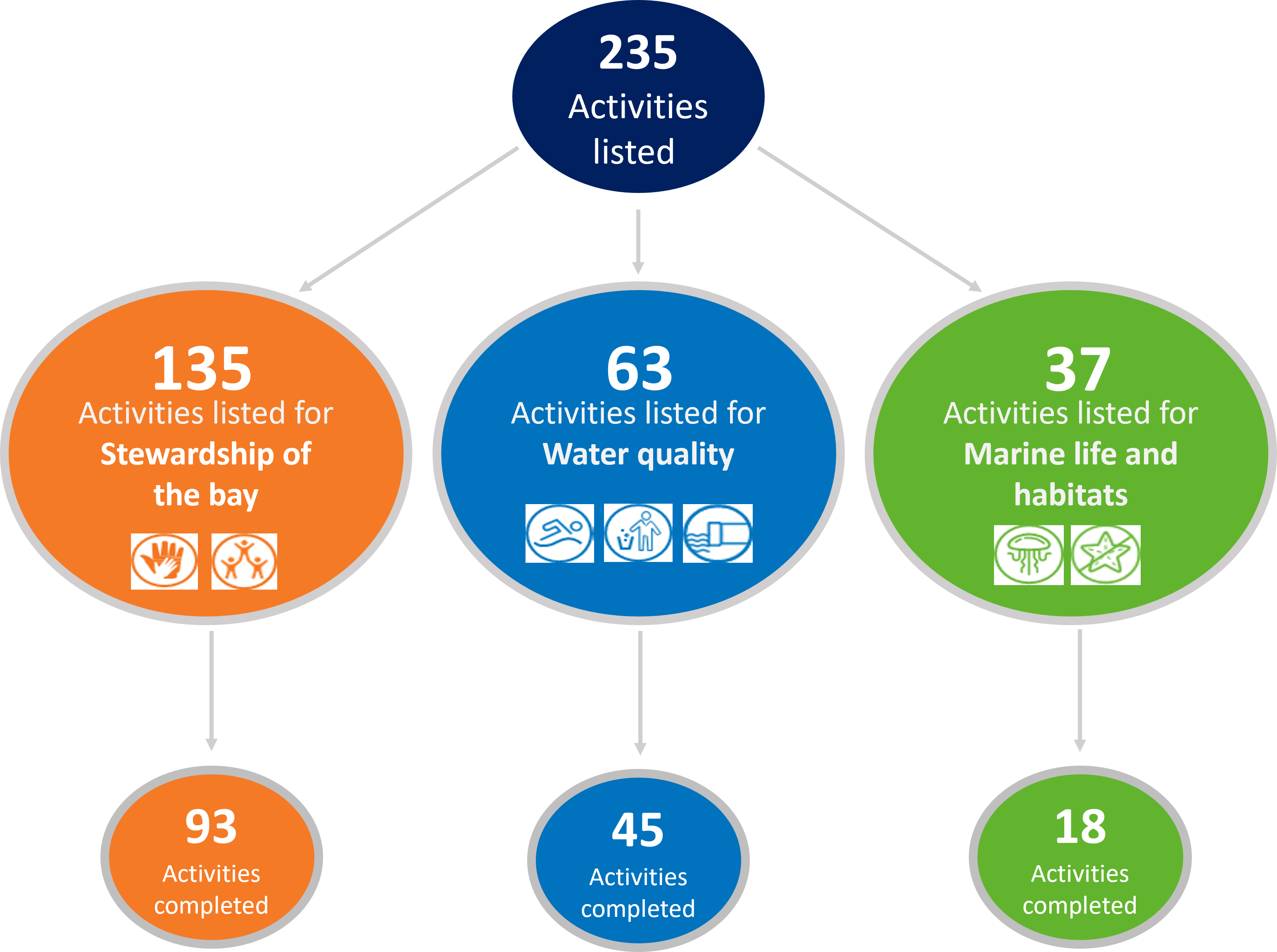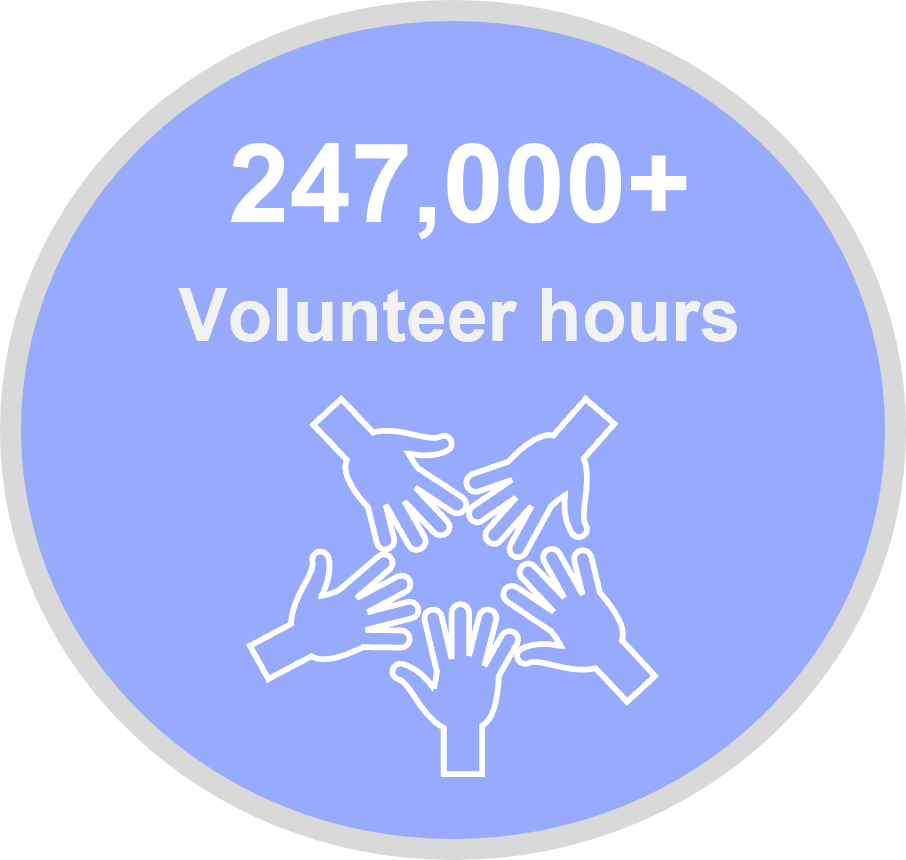Progress 2020-2021
Details on all activities, including annual activity updates can be found on CoastKit in the Environmental Management Plan theme.
Of the 235 activities currently listed in the Delivery Plan, 156 have been completed. Many of the activities listed in the Delivery Plan are funded by Coastcare and the Port Phillip Bay Fund community grant programs.

The activities completed to date have enhanced knowledge of the Port Phillip Bay environment, contributed to the implementation of policy and upgraded infrastructure. The image below showcases some of the collective achievements of the Environmental Management Plan activities completed in 2017-2021. The COVID-19 pandemic had vast flow-on implications of activities reported which may impact some results. For individual activity updates or further information on activities that were paused or delayed, please see CoastKit and click on the Environmental Management Plan theme.
![]()
The end of June 2021 has seen an estimated investment of $95,421,330 towards implementing the Environmental Management Plan activities. In addition, significant in-kind contributions have been made by the many organisations contributing to the ongoing health and resilience of Port Phillip Bay. These in-kind contributions include 247,195 volunteer hours, 60,496 staff hours, $4,508,540 of cash, and $6,810,053 of other in-kind contributions, such as equipment and transport.

The chart below breaks down the value of the investment, volunteer time, in-kind cash and other in-kind contributions against each of the Environmental Management Plan’s 3 goals.
For further information on how this investment has been used please view Achievements and Case studies.
Annual report card indices have been created to enable development of key performance indicators and targets for the Port Phillip Bay Environmental Management Plan 2017-2027's (EMP) Monitoring, Evaluation, Reporting and Improvement Framework (MERI). The MERI is a key part of the overall delivery process enabling evaluation of the effectiveness and efficiency of the EMP. The report cards, and by extension the MERI, will link to other government agency monitoring and evaluation programs and utilise the results and/or data from these to help evaluate the EMP.
The report cards also support regular evaluation and adaptation of the Delivery Plan. The report cards will be published annually with the Annual Report and Delivery Plan Update. The first of these annual report cards, for the stewardship goal and the pathogens and habitat and marine life priority areas of the EMP have been published here. The Water Quality Index, developed annually by the Environment Protection Authority Victoria and used by the EMP to report on the Nutrients and Pollutants priority area, and the Index of Estuarine Condition, which establishes a baseline of estuarine condition for future assessment, have been included here. An analysis of existing litter data has also been published.
Future improvements to these annual report cards includes publication of additional report cards to cover outstanding priority areas and expansion of the existing report cards to include additional indices and the results of additional monitoring programs.
To support the addition of new activities to the Delivery Plan, the structure of the reference numbers was updated from X.Y.Z.A to X.Y.00Z.AA where:
- X, a numeral, references the strategy
- Y, a numeral, references the priority action
- Z, a numeral, numbers the activities under the priority action
- A, a letter, references the sub-activity for multi-part activities.
This update will ensure the Environmental Management Plan database, established in 2020, can sort the activities in the correct order.
The Delivery Plan outlines funded activities across government, industry and the community, that align with the objectives and priorities of the Environmental Management Plan. These will be progressively achieved with new activities identified and added over the Environmental Management Plan’s ten-year implementation. CoastKit contains the details of all activities listed in the Delivery Plan.
Case studies 2020-2021
The case studies provided by various organisations are activities listed in the 2021 Delivery plan.
Activity name: Street to Bay - Litter Survey of Port Phillip Bay Catchment
Activity reference number: 2.2.002.AE
Strategic lead: The Scout Association of Australia, Victorian Branch
Responding to a lack of reliable data on the source of litter and pollution entering Port Phillip Bay, the Street to Bay – Litter Survey of Port Phillip Bay Catchment activity aimed to better understand the source of the problem, inspire youth to drive change in the community and for the data to impact policy.
The Street to Bay – Litter Survey of Port Phillip Bay Catchment activity, delivered through the Port Phillip Bay Fund and led by Scouts Victoria in partnership with the Port Phillip EcoCentre, received $99,835 to develop a representative database of litter sources across the entire Port Phillip Catchment. Scout Association youth were at the heart of this project, conducting surveys and subsequently inspiring change by engaging and communicating outcomes and alternative litter management solutions to councils, state and federal Members of Parliament and community groups.
The project:
- Developed recruitment, education and training systems to measure and record litter and microplastics from 6 different street use types in the catchment (retail, public building, industrial, residential, park and sports field sites)
- Delivered litter education programs to 27 Scout Groups
- Recruited 25 Scout Groups located in the Port Phillip Catchment area to complete 546 litter audits, requiring 3300 volunteer hours
- Collected and categorised 54,000 pieces of litter
- Held youth-led meetings with mayors from 12 Councils and 12 state and federal MP’s to raise awareness of the issue and outcomes of the litter audits
- Delivered a youth-led awareness campaign on a local level.
The Street to Bay – Litter Survey of Port Phillip Bay Catchment activity increased awareness of microplastics and other plastic waste in Port Phillip Bay.
Activity name: Stormwater planning capacity building initiatives for urban developments
Activity reference number: 3.3.006
Strategic lead: Department of Energy, Environment and Climate Action
Supporting planning applicants and assessors to meet Victoria’s urban stormwater planning requirements for greener environments and healthier waterways and bays.
The Department of Energy, Environment and Climate Action, in partnership with Clearwater, have developed an Online Navigator Tool Resource Portal for understanding Victoria’s stormwater planning requirements.
This comprehensive guide supports urban planning applicants and development assessors to identify requirements set out in the Victoria Planning Provisions that help protect the health of waterways from stormwater runoff.
Meeting Victoria’s stormwater planning requirements – using the Online Navigator Tool Resource Portal
The Resource Portal is a comprehensive, non-statutory guide supported by checklists and context specific guidance and resources, to help users meet Victoria’s stormwater planning requirements. The video below demonstrates how to use the Tool.
The Online Navigator Tool is made up of a series of questions and undertakes a decision tree pathway to determine what stormwater planning clauses and objectives apply to the development. The Tool's resources also help when developing a stormwater report, including:
- Site layout plan, catchment areas and stormwater treatments
- Modelling to demonstrate compliance
- Functional design consideration
- Site management plan
- Asset maintenance program.
Navigating the Tool is easy. You simply scroll up and down the page, using the banners to move back a step if the user would like to change their answer to a previous question.
Once completed, the Online Navigator Tool provides resources relevant to the development and sets out measures to incorporate into the project to help meet stormwater planning requirements. The full range of the Online Navigator Tool's resources can be accessed via the Resources page. The video below demonstrates how to use the Resources page.
Activity name: Port Phillip Bay Shellfish Reef Restoration Project
Activity reference number: 6.3.001.AB
Strategic lead: The Nature Conservancy
The Nature Conservancy is leading an ambitious project to restore the lost shellfish reefs of Port Phillip Bay. Shellfish reefs are a collapsed ecosystem, depleted through historical overharvesting and compounded by catchment to coast runoff, disease and invasive species. The environmental conditions in Port Phillip Bay are now ideal to rebuild these reefs. In October 2020, 3.5 hectares of shellfish reefs were restored at 9ft Bank and Wilson Spit in outer Geelong Harbour, Margaret’s Reef in Hobsons Bay near St Kilda and Dromana. These works built on the 2.5 hectares already restored between 2017 and 2019 in activity 6.3.001.AA. Shellfish reefs will help improve the health of Port Phillip Bay by improving water quality, increasing fish stocks and providing habitat for an array of other flora and fauna species.
As part of the ecological restoration reconstruction approach, a reef base is first constructed out of limestone rubble and for some of the reefs out of a combination of limestone and recycled shell. These reefs are then seeded with hatchery reared native flat oysters and blue mussels grown by aquaculture farmers. In 2020, the 3.5 hectares of reefs were seeded with 3,700,000 oysters and 690,000 mussels. The shellfish reef restoration work in Port Phillip Bay will continue in late 2021 and early 2022, in activity 6.3.001.AC, with another 5 hectares being added to the existing sites as part of a national Reef Builder initiative.
Undertaking restoration work in the marine environment is typically much more challenging than on land. There are additional logistics of working in the water, including, for example, finding load out sites for the reef base materials and changing weather conditions.
Page last updated: 30/10/25